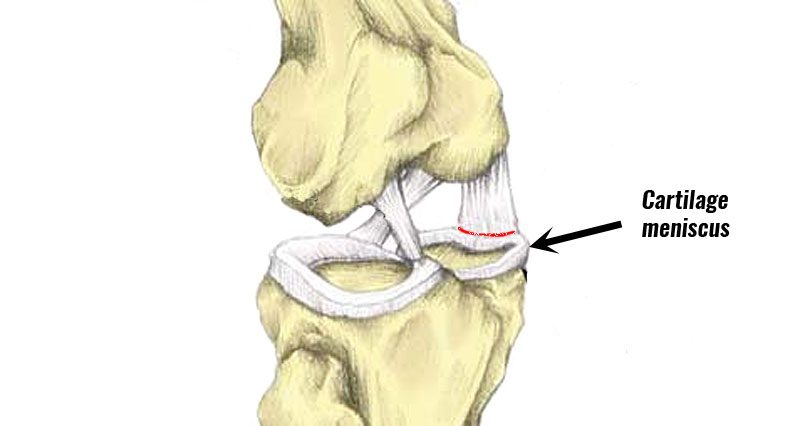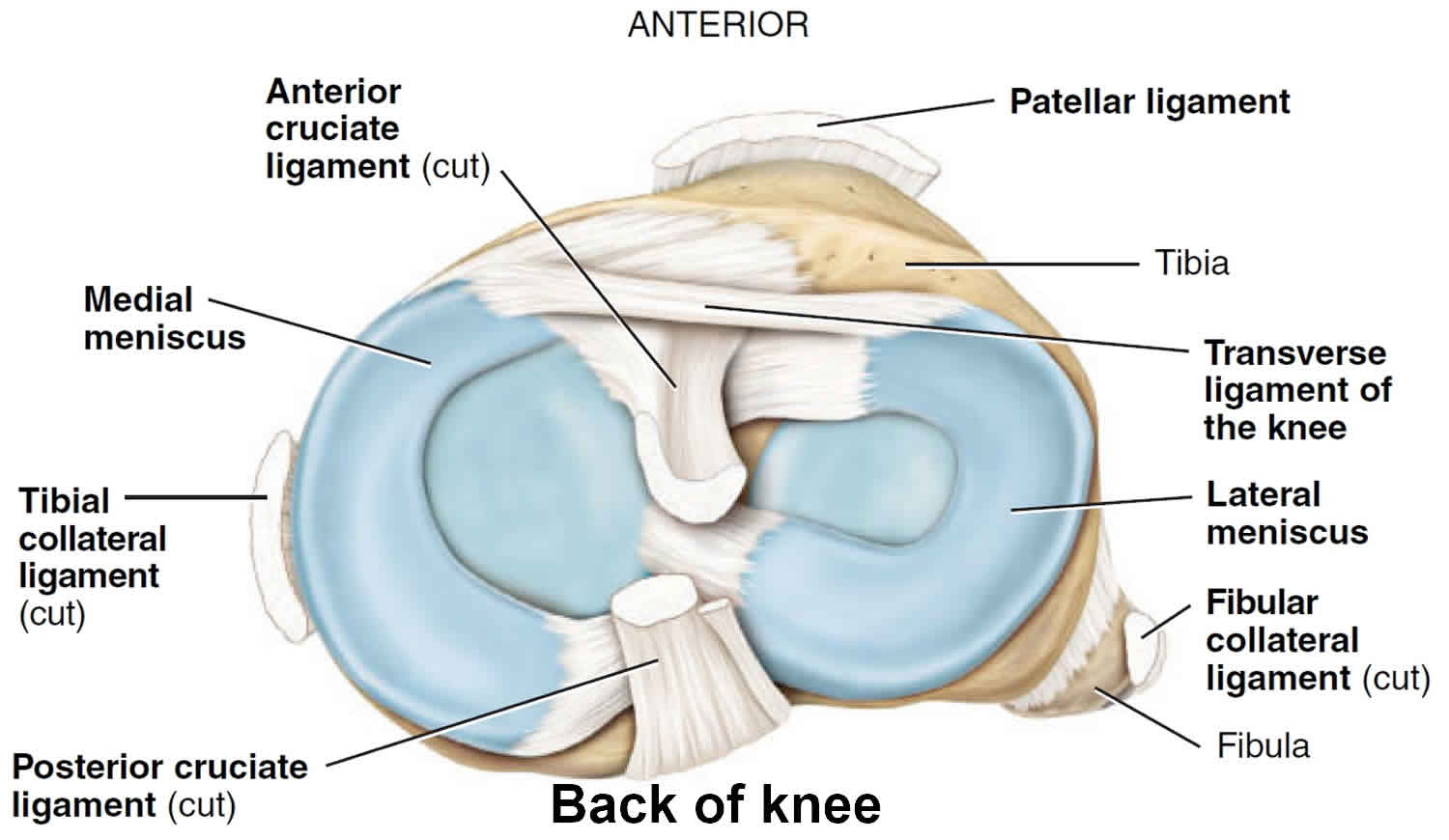Anatomy and Function of the Meniscus

The meniscus is a C-shaped piece of cartilage that acts as a shock absorber and stabilizer in the knee joint. It sits between the femur (thighbone) and the tibia (shinbone), providing cushioning and distributing weight evenly across the joint.
Structure and Location, Meniscus tear
The meniscus is composed of fibrocartilage, a tough and flexible tissue that is more resilient than regular cartilage. It has two distinct parts: the medial meniscus, located on the inner side of the knee, and the lateral meniscus, located on the outer side. The medial meniscus is larger and more C-shaped than the lateral meniscus, which is more oval in shape. Both menisci are attached to the tibial plateau by ligaments and have a central region called the “meniscal root.”
Functions of the Meniscus
The meniscus plays a crucial role in maintaining knee joint health and function. Its primary functions include:
- Shock absorption: The meniscus acts as a cushion, absorbing impact forces during activities like walking, running, and jumping. This helps protect the joint from damage and wear and tear.
- Weight distribution: The meniscus distributes weight evenly across the knee joint, reducing stress on the cartilage and preventing premature wear.
- Joint stability: The meniscus helps stabilize the knee joint by limiting excessive movement and preventing the femur from sliding off the tibia.
- Lubrication: The meniscus helps lubricate the knee joint, reducing friction between the bones and allowing for smooth movement.
Types of Meniscus Tears
A meniscus tear occurs when the cartilage is torn or damaged. This can happen due to a sudden injury, such as a twisting or pivoting motion, or from overuse and degeneration over time. Meniscus tears can be classified based on their location, size, and shape:
- Horizontal tear: This type of tear runs across the width of the meniscus, usually caused by a twisting injury.
- Vertical tear: This type of tear runs along the length of the meniscus, often caused by a direct impact or a sudden twisting motion.
- Radial tear: This type of tear starts at the outer edge of the meniscus and extends inward, often caused by a sudden twisting motion.
- Bucket-handle tear: This type of tear is a large, vertical tear that resembles a bucket handle, often caused by a significant twisting injury.
Symptoms of Meniscus Tears
Symptoms of a meniscus tear can vary depending on the severity of the tear. Some common symptoms include:
- Pain: Sharp pain in the knee, especially during or after activity.
- Swelling: Swelling around the knee joint.
- Stiffness: Difficulty bending or straightening the knee.
- Clicking or popping: A clicking or popping sound when moving the knee.
- Locking: The knee may feel locked or stuck in a bent position.
- Giving way: The knee may feel unstable or give way, making it difficult to walk or stand.
Diagnosis and Treatment Options

Diagnosing and treating a meniscus tear involves a comprehensive approach, considering the severity of the tear, the patient’s age, and activity level. A combination of physical examination, imaging tests, and arthroscopy is often employed to confirm the diagnosis and guide treatment decisions.
Physical Examination
A thorough physical examination is crucial in diagnosing a meniscus tear. The doctor will evaluate the patient’s symptoms, including pain, swelling, and difficulty with movement. They will also perform specific tests to assess the stability of the knee joint and check for any signs of instability or locking.
Imaging Tests
Imaging tests play a significant role in confirming the diagnosis and determining the extent of the tear.
- X-rays are often used initially to rule out other conditions, such as fractures. While X-rays cannot directly visualize the meniscus, they can help identify any bone abnormalities that may be associated with a meniscus tear.
- Magnetic Resonance Imaging (MRI) is the gold standard for diagnosing meniscus tears. MRI provides detailed images of the soft tissues in the knee, allowing doctors to clearly visualize the meniscus and identify the location, size, and type of tear.
Arthroscopy
Arthroscopy is a minimally invasive surgical procedure used to visualize the inside of the knee joint. It is often performed to confirm the diagnosis, assess the severity of the tear, and perform necessary treatment. During arthroscopy, a small camera and surgical instruments are inserted into the knee joint through tiny incisions. This allows the surgeon to directly visualize the meniscus and perform procedures such as meniscectomy or meniscus repair.
Treatment Options
Treatment options for meniscus tears vary depending on the severity of the tear, the patient’s age, and their activity level.
Conservative Treatment
Conservative treatment options are often the first line of defense for meniscus tears. These approaches aim to reduce pain and inflammation, promote healing, and restore function.
- RICE (Rest, Ice, Compression, Elevation): This basic treatment regimen helps reduce swelling and pain. Resting the knee, applying ice packs, compressing the area with a bandage, and keeping the leg elevated can significantly alleviate discomfort.
- Physical Therapy: Physical therapy plays a crucial role in rehabilitation after a meniscus tear. A physical therapist will develop an individualized exercise program to strengthen the muscles surrounding the knee, improve range of motion, and restore stability.
- Medications: Over-the-counter pain relievers, such as ibuprofen or naproxen, can help manage pain and inflammation. In some cases, doctors may prescribe stronger pain medications or steroid injections to reduce inflammation and pain.
Surgical Treatment
Surgical interventions are considered when conservative treatments fail to provide adequate relief or when the tear is severe.
- Meniscectomy: This procedure involves removing the torn portion of the meniscus. It is often performed for tears that are located in the outer portion of the meniscus, which has a better blood supply and is more likely to heal. Meniscectomy can be performed using arthroscopic techniques, which are minimally invasive.
- Meniscus Repair: This procedure involves stitching the torn portion of the meniscus back together. It is typically performed for tears that are located in the inner portion of the meniscus, which has a poor blood supply and is less likely to heal on its own. Meniscus repair is usually performed using arthroscopic techniques and requires a period of immobilization and rehabilitation.
Choosing the Right Treatment
The best treatment option for a meniscus tear depends on several factors, including:
- Severity of the Tear: The size, location, and type of tear can influence the choice of treatment. Smaller tears may respond well to conservative treatment, while larger or more complex tears may require surgery.
- Age: Younger patients with a good blood supply are more likely to benefit from meniscus repair. Older patients may be more likely to undergo meniscectomy due to a lower chance of successful healing.
- Activity Level: Patients who are highly active may require surgery to restore full function and prevent future injury. Less active individuals may be able to manage their symptoms with conservative treatment.
Rehabilitation and Recovery: Meniscus Tear

Recovering from a meniscus tear requires a structured rehabilitation program designed to restore function and minimize the risk of further injury. The program typically involves a combination of exercises, physical therapy, and gradual return to activity. The success of rehabilitation depends on the severity of the tear, the individual’s overall health, and their commitment to the program.
Rehabilitation Program
A comprehensive rehabilitation program for a meniscus tear typically involves three phases:
- Phase 1: This initial phase focuses on reducing pain and inflammation, protecting the injured knee, and restoring range of motion. It may include:
- Rest and ice application to decrease inflammation.
- Elevation of the leg to reduce swelling.
- Pain management with medications, such as over-the-counter pain relievers or prescription pain medications.
- Gentle range of motion exercises, such as ankle pumps, quadriceps sets, and hamstring curls.
- Phase 2: This phase focuses on strengthening the muscles surrounding the knee, improving flexibility, and regaining balance. It may include:
- Progressive strengthening exercises, such as leg presses, hamstring curls, and calf raises.
- Stretching exercises to improve flexibility and range of motion.
- Balance exercises to improve coordination and stability.
- Proprioceptive exercises, which help to improve the sense of joint position and movement.
- Phase 3: This final phase focuses on returning to activity and regaining functional capacity. It may include:
- Gradual increase in activity levels, such as walking, jogging, and sports-specific drills.
- Continued strengthening and flexibility exercises.
- Functional exercises, such as jumping, hopping, and cutting drills.
- Return to sports or other activities, depending on the individual’s progress and the nature of their injury.
Importance of Following a Structured Rehabilitation Plan
Following a structured rehabilitation plan is crucial for optimal recovery and minimizing the risk of re-injury. The plan provides a gradual and progressive approach to healing, ensuring that the knee is not overloaded before it is ready. Adhering to the prescribed activity restrictions is essential to allow the tissues to heal properly.
“It is important to follow your physical therapist’s instructions carefully and to progress through the rehabilitation program at a pace that is comfortable for you. If you experience any pain or discomfort, stop the exercise and consult with your physical therapist.”
Expected Recovery Timeline
The recovery timeline for a meniscus tear varies depending on the severity of the tear, the individual’s overall health, and the treatment received.
- Minor tears: May heal within a few weeks with conservative treatment.
- Moderate tears: May take several months to heal.
- Severe tears: May require surgery and a longer rehabilitation period, potentially up to a year or more.
Potential Complications
While most people recover well from a meniscus tear, some may experience complications during the rehabilitation process. These complications can include:
- Re-injury: Returning to activity too soon or without proper conditioning can increase the risk of re-injury.
- Stiffness: Limited range of motion can occur if the knee is not properly mobilized during the rehabilitation process.
- Arthritis: Long-term damage to the meniscus can increase the risk of developing osteoarthritis.
- Infection: This is a potential complication of surgery, but it is relatively rare.
A meniscus tear is a common injury, especially among athletes. It occurs when the cartilage in the knee, known as the meniscus, is torn. This can happen due to a sudden twisting motion or a direct impact to the knee.
One recent example of this type of injury is the jahmyr gibbs injury , which has sidelined the talented running back. Depending on the severity of the tear, treatment for a meniscus tear can range from physical therapy to surgery.
A meniscus tear is a common injury that can occur in the knee, often caused by sudden twisting or forceful impact. Recovering from a torn meniscus requires careful attention to healing and rehabilitation. To learn more about the process of torn meniscus recovery , it’s important to understand the various treatment options available, including physical therapy, surgery, and pain management.
With proper care and guidance, individuals can regain their mobility and return to their active lifestyles after a meniscus tear.
